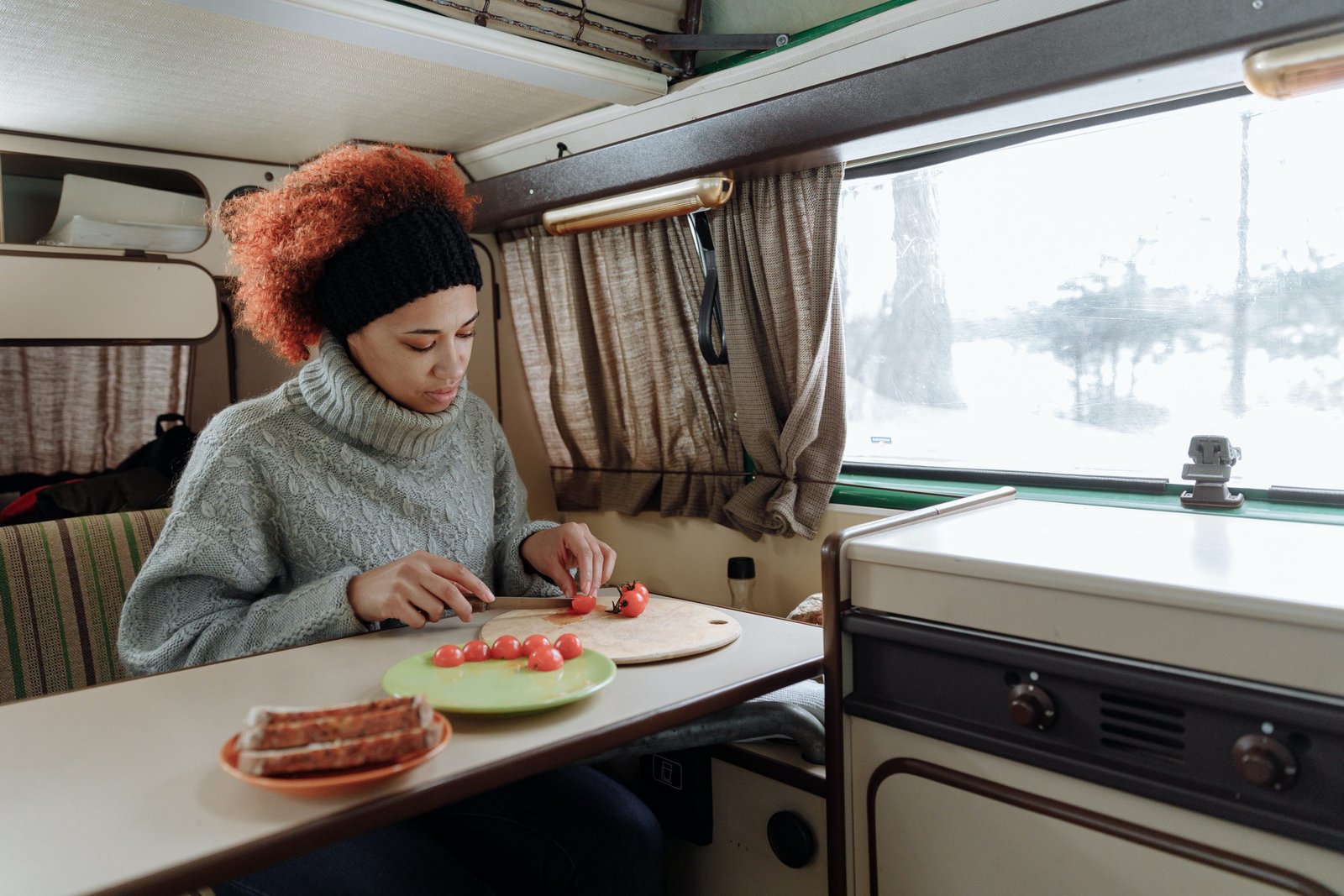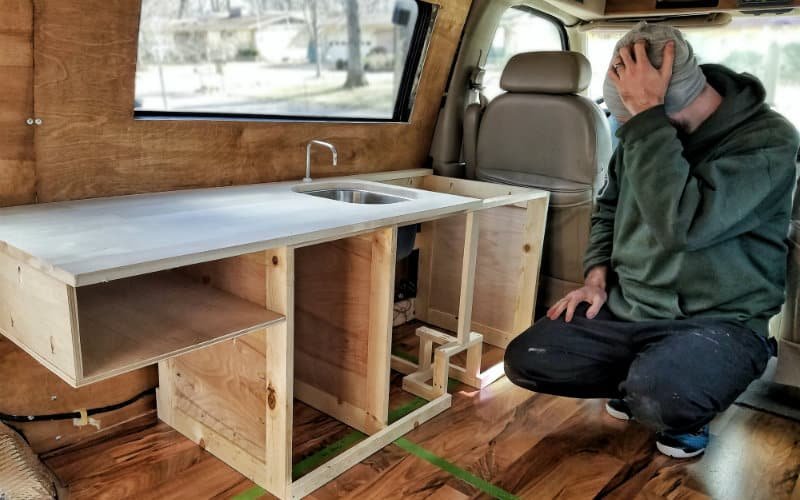
Sustainable Travel & Eco-Tips for Campervan Owners
June 5, 2023
Choosing a Mini Camper Van – Big Adventures with Little Space
August 1, 2023Campervan Kitchens Ultimate Guide: Designs, Safety & More



Your campervan is your ticket to relaxing holidays on-the-go, providing you with a safe and comfortable spot to sleep at night, without the costs of a B&B or hotel.
But you don’t only need to sleep while you’re adventuring – you’ll need to eat as well. And adding a kitchen space to your campervan can help you take your culinary skills on the road with you, meaning you can enjoy balanced, tasty meals prepared fresh.
Camper Van Kitchen Guide Contents
- Campervan Kitchens Ultimate Guide: Designs, Safety & More
- Campervan Kitchen Essentials
- Stocking Up Your Campervan Kitchen
- Campervan Kitchen Health & Safety
- Is it Safe to Cook in a Campervan?
- Design Ideas for Campervan Kitchens
- What is the Best Material for Campervan Cabinets?
- Maximising Storage in a Camper Van Kitchen
- Camper Van Kitchens: Final Word
Campervan Kitchen Essentials
A kitchen is only as good as the equipment you have in it, but with a campervan you have limited space. So, it’s important that you prioritise the right features and facilities.
Ideally, you’ll want three separate spaces within your camper van kitchen:
- Somewhere to prep
- Somewhere to cook
- Somewhere to clean

Even if you only have a relatively small worktop area, you can usually divide it up into thirds. Gas stoves for a campervan can be relatively small (you likely won’t have a 4-burner hob like you would at home), and campervan sinks don’t need to be huge.
If space is really limited, you can sacrifice one or two of these ‘zones’. It might be that you prefer to use a campsite’s cleaning facilities to wash up your pots and plates, and you intend to cook al fresco every day. The kitchen may just be where you prepare meals before it’s time to cook them.
However, the point of having a kitchen in a campervan is to open up the options you have for prepping meals. So, look at the space you have available, and consider the types of meals you and your family enjoy, and then prioritise cooking equipment based on that.
There are some amazing campervan storage hacks that can help you make the most of the space and ensure you do not leave any essential kitchen items behind!
Depending on the space you have available, and the electrical connections, you may want to incorporate:
- A stove/hob
- A microwave
- A slow cooker
Stocking Up Your Campervan Kitchen
But a kitchen is about so much more than just the cooking equipment. You’ll also need to think about stocking it with the following:

- Plates and bowls – ideally made using a lightweight material such as plastic or bamboo
- Drinking glasses – collapsible ones help to save space
- Cutlery and food prep utensils, such as knives, a grater and a peeler
- Pans – one or two multipurpose pans will typically be enough
- A kettle – a whistling kettle is a good choice as it can be used on indoor and outdoor stoves. 12v travel kettles are very slow to boil
- Tea towels & kitchen roll
- A bottle opener for those all important cold drinks after a busy day!
Again, consider what kind of meals you want to cook, and then plan your kitchen accordingly. If you never intend to grate cheese, then don’t bother buying a grater, no matter how ‘space saving’ an option you find.
In terms of bigger appliances, it’s rare to have a proper refrigerator inside a camper van kitchen. You may have a travel mini fridge, but these consume a lot of power. It’s often better to use a cool box to take some ingredients/meals with you, and then buy fresh food as you go, or use tinned/dry foods that last longer.
Campervan Kitchen Health & Safety
There are a few things you need to bear in mind when designing a campervan kitchen in order to keep it safe.

Storage: First up is secure storage. Your kitchen is going to be home to a large number of items, some of which may be heavy, and some of which may be sharp. You need to make sure you have provided safe spaces to keep this equipment secure while you’re travelling. Bungee cords, secure nets and magnets are just a few of the techniques campers use to keep them safe on the road!
Latches: You can install latches on your cupboards and drawers to keep them securely closed until you reach your destination. This is also a good idea for people travelling with young children to keep them out of cupboards with sharp knives or cleaning products. Add non-slip mats as lining for your cupboards, so that you minimise the amount of movement your pots and pans are going through with any sharp turns on the road.


Fire & Ventilation: Don’t hang curtains on a window if it’s above a stove and keep anything else flammable well clear of the space you’re using to cook. You need good ventilation too. If the gas doesn’t ignite immediately or there’s a leak, you have to make sure you have fresh air flowing through the compact space. Plus, you don’t want smoke to build up inside as that can be toxic for you as well. Always have a fire extinguisher on-hand in case of emergencies, and make sure you know how to operate it.
Knives & Counter Tops: You also need to consider the safety of your prep surfaces. Your kitchen needs to be built to a high standard with level countertops. Using sharp blades in cramped conditions is difficult enough, but doing so on uneven surfaces can be very dangerous. It pays to keep your cooking knives sharp – blunt knives are more likely to slip and cause injuries.

Is it Safe to Cook in a Campervan?
Cooking in a campervan is safe, as long as you stick to some common-sense rules. Never leave cooking unattended and keep anything flammable far away from any open flame. Have a fire extinguisher close at hand in case of emergencies.
When done safely, campervan cooking is not only safe, but an amazing experience that will enhance your camping experience. Our Complete Guide to Campervan Cooking has some fantastic recipes and tips to help you level up your camper van kitchen adventures!
Design Ideas for Campervan Kitchens

There is no single ‘standard’ kitchen design for a camper van. That’s part of what makes campervans so much fun – you can customise them completely to your own taste, and you’d be surprised at just what is possible even in such a limited space.
First through, you need to consider layout. A campervan kitchen depends entirely on how much room you want to commit for this ‘room’, bearing in mind sleeping space has to take priority.
If you have a pop-top bedroom, then you have much more space for a kitchen, otherwise you may have to restrict yourself to a single unit. Some campervan kitchens are L-shaped, accessible from the side door of the camper, while others tend to run along one wall. Bigger campervans may have units along both walls, or even a u-shaped kitchen.
Consider your cabinet design: The cheapest options will be basic and functional, or if you have the cash to splash, you can find some fantastic inspiration online for different unit designs, which rival the best kitchens you’ll see in modern homes.
Choose handles carefully: You don’t want anything with sharp edges or that protrudes too far if you’re squeezing past all the time. Also consider electrical connections – if your installation is simple, you’ll want to keep any wiring to one side of the van, so plan for that.
What is the Best Material for Campervan Cabinets?

There are two materials commonly used for campervan cabinets – wood and aluminium.
Aluminium tends to be a lighter weight, so is good for larger installations if you’re concerned about the weight limits for your campervan. However, it’s not as premium-looking. Wood looks nicer, and is easier to adjust too, if the cabinets don’t fit the space perfectly.
But if you’re using wood and you’re having a larger kitchen, you’ll need to check that you aren’t overloading your campervan.
Countertops will typically be made from plywood, stainless steel or plastic laminate. Laminate tends to be used as a cover for an existing countertop, so you may have a plywood counter with laminate coating.
Use plywood if you want a thicker countertop – steel counters have to be thin to keep the weight down.
Maximising Storage in a Camper Van Kitchen
When planning your kitchen, you need to think about maximising the space you have. Even with a large kitchen, you’ll have a lot of essential items that you don’t want to be cluttering up the countertop.
Some top tips for making the most of storage space:
- Think vertical – can you add additional storage to the walls, or storage hangers for pots, pans and smaller utensils
- Buy collapsible and stackable items to use in your kitchen
- Use seating that has hidden storage space for items you don’t need regular access to
- Only bring what you need, including smaller packets of herbs, spices and seasonings instead of large jars or bottles

Camper Van Kitchens: Final Word
Don’t rush into any decisions with a campervan kitchen, whether having one professionally fitted or making your own DIY option.
The purpose of a camper van kitchen is to be more comfortable than ‘roughing it’ with an outdoor stove, so plan your layout and equipment to suit what you want and need. With a bit of thought, you can have a space that you’ll love using every day of your camping adventures.






